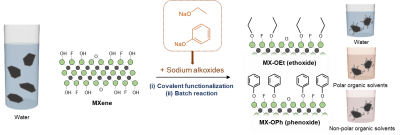Newswise — Dr. Seon Joon Kim and his team at the Korea Institute of Science and Technology (KIST)’s Convergence Research Center for SEIF have developed a “high-conductivity amphiphilic MXene” material that can be dispersed in water, polar and nonpolar organic solvents. This is an achievement that fundamentally overcomes the solvent compatibility limitation that has hindered the practical use of high-conductivity MXene, and is noted as a general-purpose technology that can be widely applied to high-tech industries in the future.
MXene, a two-dimensional nanomaterial with high electrical conductivity, excellent solvent dispersibility, and excellent EMI shielding performance, is expected to find applications in a variety of fields, including secondary batteries, advanced sensors, stealth paints, and EMI shielding films. However, so far, MXene has been mostly hydrophilic, which means that it disperses well in water but is difficult to apply in various organic solvents. This has limited their compatibility with practical processes such as polymer composites and ink processes.
The researchers developed the world’s first surface modification technology that introduces alkoxide organic monomers to the surface of MXene, making it both hydrophilic and hydrophobic, giving it amphiphilic properties. This technique enabled MXene to be stably dispersed in a wide range of solvents, from water (with a high solvent polarity index) to toluene (with a low solvent polarity index).
In addition, the developed amphiphilic MXene exhibited better coating properties and EMI shielding performance than conventional MXene. Inks formulated from amphiphilic MXene was uniformly coated on copper and aluminum substrates, which are widely used as collectors for secondary batteries, and also on commercial polymer substrates such as polyimide and PET, as well as on Teflon substrates, which have the highest hydrophobicity. It also maintained excellent EMI shielding performance in the 28 GHz region, a key frequency band used in next-generation communications, and exhibited shielding performance of more than 50 dB (blocking more than 99.999% of electromagnetic waves) even in a very thin film with a thickness of 0.01 mm.
The newly developed MXene is a general-purpose technology that can be applied to EMI shielding materials for future mobility such as autonomous vehicles, manufacturing electrode materials for secondary batteries based on a solution process, and radio wave absorption composites for stealth unmanned aerial vehicles, and is expected to have a significant scalability and industrial impact.
“This achievement is a technological milestone that proves that MXene materials can be directly applied to industrial field processes beyond lab scale,” said Dr. Seon Joon Kim at KIST. “We are currently working with domestic and foreign MXene companies to expand toward mass production-based technologies and accelerate the transition to the commercialization stage.”
###
KIST was established in 1966 as the first government-funded research institute in Korea. KIST now strives to solve national and social challenges and secure growth engines through leading and innovative research. For more information, please visit KIST’s website at https://www.kist.re.kr/eng/index.do
This research was supported by the Ministry of Science, ICT and Future Planning (MSIT) and the Ministry of Trade, Industry and Energy (MOTIE) under the KIST Institutional Program, Future Leading Convergence Research Center (CRC22031-000), and the Global Industrial Technology Cooperation Center (P0028332). The research was published in the latest issue of the international journal Advanced Materials (IF 26.8, JCR field 2.1%).
